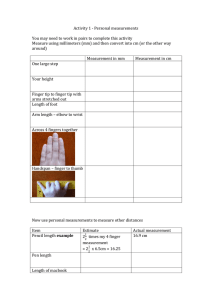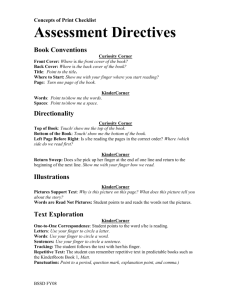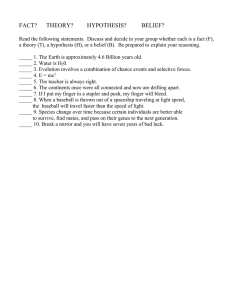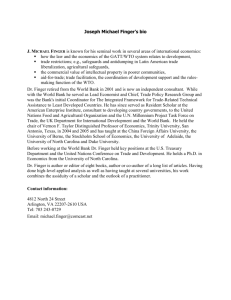Fingered Flow in Two Dimensions
advertisement
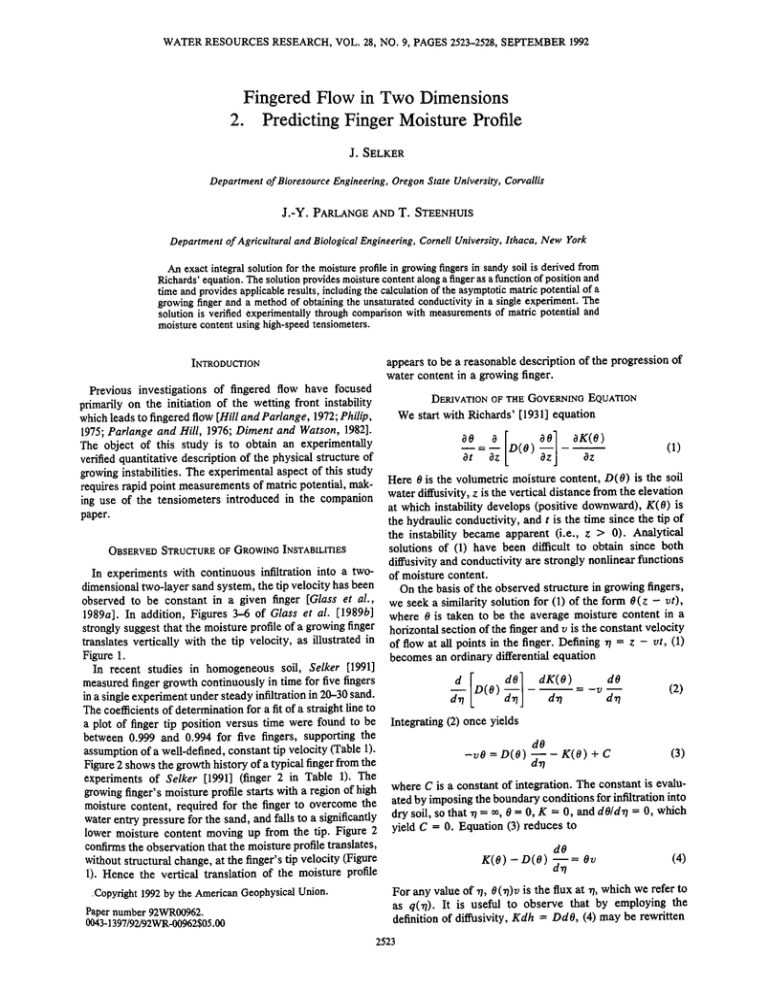
WATER RESOURCES RESEARCH, VOL. 28, NO. 9, PAGES 2523-2528, SEPTEMBER 1992
Fingered Flow in Two Dimensions
2. Predicting Finger Moisture Profile
J. SELKER
Department of BioresourceEngineering,Oregon State University,Corvallis
J.-Y.
PARLANGE AND T. STEENHUIS
Departmentof AgriculturalandBiological
Engineering,
CornellUniversity,
Ithaca, New York
An exactintegralsolutionfor the moisture
profilein growingfingersin sandysoilis derivedfrom
Richards'equation.
Thesolution
provides
moisture
contentalonga fingerasa functionof positionand
timeandprovides
applicable
results,including
thecalculation
oftheasymptotic
matticpotentialof a
growing
fingeranda methodof obtaining
theunsaturated
conductivity
in a singleexperiment.
The
solution
is verifiedexperimentally
through
comparison
withmeasurements
of matricpotentialand
moisture content using high-speedtensiometers.
appears
tobea reasonable
description
of theprogression
of
INTRODUCTION
water content in a growing finger.
Previousinvestigationsof fingeredflow have focused
DERIVATIONOF THE GOVERNING EQUATION
primarily
on the initiationof the wettingfrontinstability
We start with Richards' [ 1931] equation
whichleadsto fingeredflow [Hill andParlange,1972;Philip,
1975;Parlangeand Hill, 1976;Dimentand Watson,1982].
The objectof this studyis to obtainan experimentally
• = -- D(O)
(1)
ot
oz
oz
verifiedquantitative
description
of thephysicalstructure
of
growing
instabilities.
Theexperimental
aspectof thisstudy Here 0 is the volumetricmoisturecontent,D(0) is the soil
requires
rapidpointmeasurements
of matricpotential,
mak- waterdiffusivity,z istheverticaldistancefromthe elevation
inguseof the tensiometers
introduced
in the companionat whichinstabilitydevelops
(positivedownward),K(0) is
paper.
thehydraulic
conductivity,
andt is thetimesincethetipof
the instabilitybecameapparent(i.e., z > 0). Analytical
solutionsof (1) have been difficultto obtain sinceboth
diffusivity
andconductivity
arestronglynonlinear
functions
OBSERVEDSTRUCTUREOF GROWINGINSTABILITIES
in experimentswith continuousinfiltrationinto a twodimensional
two-layersandsystem,thetip velocityhasbeen
observedto be constantin a given finger [Glasset al.,
1989a].In addition,Figures3-6 of Glasset at. [1989b]
strongly
suggest
thatthemoisture
profileof a growing
finger
translates
verticallywith the tip velocity,as illustrated
in
of moisture content.
Figure 1.
becomesan ordinarydifferentialequation
On the basisof the observedstructure in growing fingers,
we seeka similaritysolutionfor (1) of theform O(z - vt),
where 0 is taken to be the averagemoisturecontentin a
horizontalsectionof thefingerandv is the constantvelocity
of flowat all pointsin thefinger.Definingr• = z - vt, (1)
In recent studiesin homogeneous
soil, Selker [1991]
measured
fingergrowthcontinuously
in timefor fivefingers
d D(0)
ina single
experiment
understeady
infiltration
in20-30sand.
d•
The coefficientsof determinationfor a fit of a straightline to
-v dw
dw
(2)
a plotof fingertip position
versustimewerefoundto be Integrating(2) onceyields
between0.999 and 0.994 for five fingers,supportingthe
dO
assumption
ofa we!l-defined,
constant
tipvelocity
(Table1).
-vO=D(O)
• K(O)
+C
(3)
Figure
2 shows
thegrowth
history
ofatypicalfinger
fromthe
experiments
of Selker[1991](finger2 in Table 1). The whereC is a constantof integration.The constantis evalugrowing
finger's
moisture
profilestartswitha region
ofhigh
theboundary
conditions
forinfiltration
into
moisture
content,required
for the fingerto overcome
the atedbyimposing
dry
soil,
so
that
r/=
m,
0
=
0,
K
=
0,
and
d
O/dw
=
0,
which
waterentrypressure
forthesand,andfallsto a significantly
lowermoisturecontentmovingup from the tip. Figure2 yieldC = 0. Equation(3) reducesto
confirms
the observation
thatthe moistureprofiletranslates,
dO
•
without
structural
change,
atthefinger's
tipvelocity
(Figure
1). Hencethe verticaltranslationof the moistureprofile
Copyright
1992by theAmerican
Geophysical
Union.
Papernumber92WR00962.
0043-1397/92/92WR-00962505.00
K(O)
- D(O)
= Ov
(4)
Foranyvalueof r/, 0(r/)vis thefluxat ,/, whichwereferto
as q(r/). It is usefulto observe
thatby employing
the
definition
of diffusivity,
Kdh = DdO, (4) maybe rewritten
2523
2524
Ski KER ET AL.: FINGERED FLOW IN TWO DIMFNSIONS, 2
Fingerat t = t•
Fingerat t = t1+ A t
ltfø/StOre
Profile
0
e
es
Fig. !. [;ketch of observedtranslationduringfingergrowth. The
tip of the finger, in which the moisture content is at the water entry
value, is followed by a draining tail portion. The vertical moisture
profile translates with a constant velocity.
K(O)
•
=
0
I - (dh/dn)
(5}
which gives a relationshipfor conductivity as a functionof
the gradient of matric potential and is employed later to
estimate
K/O.
While the velocity of the growing finger is constant, the
moisture content along the length of the finger is not (Figure
1). The flux into the finger q(O, t) is O0v, where O0is the
moisture content at the top of the finger:
Fig. 2. The moisturedistributionof a developing fingerin 20-30
sand. Moisture content is represented here as normalized light
intensity on the vertical axis. a.,, a function of position along the
center of the finger and time. These data were collected from a
continuous video record of transmitted light.
0
q(z, t)= q(O, t)-
00
(6)
In the past [e.g., Glass et al., 1989a] the system flux and
finger flux have been taken as constant. Although this is true
asymptotically, for a constant v the flux in each finger must
decrease initially with decreasing moisture content in the
upper region. Hence we allow for the flux into each fingerto
be a function of time. Substituting for r• in (4) and integrating
over 0 yields
are the moisture content and pressure at the advancing front
of the finger (at r• = 0), referred to as the water entry
moisture content and water entry pressure of the soil. The
variables 0,.,. and h,,.,, may be mild functions of the initial
moisture content and dynamic factors; however, in the
fingeredflow experiments carried out by Baker and Hillel
[19901, the correlation between soil grain size and variation
in mea,,,uredhwe was found to have coefficientof determination of 0.9855 [Baker and Hillel, 1990; Selker et al., 1991].
vt - z =
•...,.
D(O
)- dO
(:..,•K(O)
z,0
(7)
Given that D(0),
K(h), and K(0) are single-valued and
-0.6
or, in terms of diffusivity, integrating over pressure,
o
z,t - ' =
t,,,.,.
dh
-0.8
(8)
,(z,OI - vO/K
where O(z, t) and h(z,
-1
O
Exp 1
I-1
Exp2
O
Exp3
t) are the moisture content and
pressureat the time and position of interest, and 0,., and h
-1.2
'7'-1.4
TABLE
I.
The Velocities of the Five Fingers Grown in 20-30
Sand
Finger
•'
-1 ø6
Velocity,cms-!
r 2'
0.314
0.369
o. 441
0.381
0.404
0.998
0.999
o. 999
0.994
0.997
[
-1.8
i
2
3
4
5
Velocities reported by Seiker [1991]. The consistency of the
velocityis verifiedby calculating
the r 2 valueof the fit between
a
straightline and the time-versus-displacement
data for each finger.
*Fit of finger tip position versus time.
-2
-•$
O
O
01-1
r-n
o•oO r-].-,[]-•o_..•r•
:w"• - o
oC•
E3r3E3
o
I
I
I
-•0
- 1$
- 10
-5
Pressure (cm)
Fig. 3. Plotof in {v/[I + (I/v)(ah/at)]} versusmatticpotential
(pressure)for three experiments.The straightline fit to the data
represents
theleastsquares
fit to thedatafromexperiments
2 and3
with a coefficient
of determination
of 0.84.
SELKER
ETAL.:FINGERED
FLOW
INTwoDIMENSIONS,
2
TABLE 2. Valuesfor A andB' ObtainedFromExperiments
1,
2, and 3 From Linear Regression,With Coefficients
of Determination
Experiment
A x 10-2
B'
r2
1 (port4)
2 (port4)
2 (port8)
3 (port 4)
4.00
2.62
2.08
2.11
-0.869
- 1.30
- 1.38
- 1.33
0.489
0.933
0.917
0.841
2, 3, 4
2.21
- 1.33
0.836
2525
and 3. Althoughmuch of the scatter in Figure 3 arisesfrom
calculationof the LHS of (10), we also note that unsaturated
conductivityis extremely sensitiveto packingand thus is
expected to show some variation in a single chamber and
betweenexperiments.
With (9), the integral given in (8) may be calculated
directly, to obtain
vt-z=2n
monotonicin the drainingportionof the finger,observethat
forany valuesof t andz therecorresponds
a uniquevalueof
O(z, t) and h(z, t) whichsatisfies(7) and(8). This solution
is essentiallythe same as found by Fleming et al. [1984,
equation(16)] when consideringone-dimensional
solutions
to the infiltrationequationbut for differentboundaryconditions.
UNSATURATED CONDUCTIVITY
which is the exact solution to Richards' equation for a
growing finger in soils where (9) holds. The asymptotic
relationshipbetweenmoisturecontent and conductivityin a
growingfingermay be found by consideringthe solutionto
(7) o.r (12) as time goes to infinity. Consideringa finite
elevation z while t goes to infinity, the numerator in the
integrandof (7) is finite, hence the denominatorof the
integrandmustgo to zero, while in (12), the argumentof the
logarithm must go to infinity. The asymptotic moisture
contentis then given by Oa with
Ka
From the measurementof matric potentialat a point in a
fingergrowingwith velocityv, (5) providesan expression
for
K/O.The relationshipbetweenK/0 andh is revealedin a plot
of the logarithm of measuredvalues of v/J1 + 1/v(Oh/Ot)]
versush, shown in Figure 3. The plot is well characterized
by a linear relationship,suggesting
that the K/0 ratio can be
relatedto pressureby the equation
K Ks
--= • exp (Ah + B)
0
Os
h < hwe
v •'
=Ah+B'
•=v
O•
(10)
where
(13)
which may be used to determine the fraction of soil participatingin conductionof the incident flux. Using the resultsof
Glasset al. [ 1990]to determinefinger size, this may be used
to obtain an expressionfor average finger spacing.
(9)
which, with (5), indicates that
v
EXPERIMENTAL VERIFICATION
Equations (9) and (12) provide an explicit relationship
between matricpotential and time in a growingfinger, which
may be compared directly with the experimental measurementsof matricpotentialin growingfingersintroducedin the
companion paper. The only parameter required to predict
the pressureversus time relationship is the growth velocity
of thefingerv, whichrangedfrom0.149to 0.20 cm s-• in
B' = B + In
(11)
these experiments.
Figure 4 givesthe resultsof tensiometerreadingstaken 1.6
and 6.7 cm below
Equation (9) is a slightly modified version of the widely
employedexponentialrelationshi
p between pressureand
conductivityintroducedby Gardner [1958].Valuesof A and
B' are estimatedusingleast squaresfit of a straightline to
the experimentallymeasuredvalues of the left-hand side
(LHS) of (10). The calculationof the LHS of (10) requires
the estimationof the derivativeof pressurewith time. This
the sand surface
in the center
of the
stimulatedfinger in experiment 2 (Figure 5). The structure
predicted in the discussionof (7) is apparent: the pressure
startsat the water entry pressureof the sandand decreases
monotonically to an asymptotic value. The pressure measured in the induction zone follows the solutions very well
until 500 s, at which time the pressurelevels off. From this
time on the pressure in the induction zone reflects the
calculation is sensitive to minor fluctuations in data which
one-dimensional
arepresentin this experiment,as givenby Selkeret al. [this
issue,Figure 11]. To providereasonableestimatesof this
derivative,the pressuredatawere smoothed
by calculation
ofthemoving30-sample
average,(averaging
dataover25 s).
The datafrom experiment4 were not appropriate
for this
calculationdue to extreme variability as a consequence
of
fingered region. Within the finger, measured at port 8, the
pressure profile very closely follows the predicted form,
departing from predicted pressure after 600 s, when the
fingermade contact with the lower boundary of the chamber.
theintermittent
irrigation.The datatakenin experiments
1,
2, and3 are shownin Figure3, with the parametric
values
fromlinearregressions
givenin Table2. The valuescalculatedfromexperiment
1 showconsiderable
scatterandthus
arenot employedin the calculationof A andB', whichare
foundto be 0.0221and-1.335, respectively•
with standard
errorof 0.0013and 0.020usingthe datafromexperiments
2
infiltration
from
the soil surface
to the
Infiltration was halted after 1300 s, at which time matric
potential was observedto fall in both tensiometers.Figures
7 and 9 of the companionpaper show the pressureprofiles
measuredin two additional experiments, revealing the same
pattern, and fit to the Richards' equation solution,found in
experiment 2.
Substituting (13) into (9) gives an expression for the
asymptotic matric potential ha which is expected in a
growingfinger:
2526
SELKERET AL.: FINGEREDFLOWIN Two DIMENSIONS,
2
-2
-4
-6
-8
.-.
E
-10
'-'
-12
m -!4
•'
-16
-18
-20
-22
-24
0
200
400
600
800
1000
1200
1400
1600
Time (seconds)
Fig. 4. Plot of matricpotentialversustimemeasured
throughports4 (opencircles)and 8 (openboxes)in
experiment2 with potentialpredictions
from(12)(solidline).At port4 the flow becomesonedimensional
at about560
s, withpressure
becoming
constant.
At port8 thepressure
dropsmoreslowlythantheprediction
for t > 600 s, that
is, when the finger reached the bottom of the chamber.
52,5
cm
5O
Setting
h• = h,,,e,oneobtains
themaximum
growth.
velocity
forafinger
intheporous
media.
If ha exceeds
hwe,thefinger
will immediately
expandin width,typicallyresulting
in the
splittingof the fingerinto two slowerfingers,as observ.
edin
a numberof'experimentalstudies[e.g., Glasset ai., 1989b].
The asymptoticmatticpotentialin the growingfingersis
quite sensitiveto fingervelocity,as show.nin Figure6,
whereh• is plottedas a functionof v f.o.rthe 40-50 sand
employedin thesestudies.As ha goesto hwewhenvelocity
increases,
thefingerbecomes
increasingly
susceptible
to the
effectsof localperturbations
whichmightcause.thefingerto
Water
Entry
Pressure
-5
E -20
-25
/,
-30
,
550
O.125
O.15
O.175
0.2
0.225
0.25
Velocity(crn/s)
Fig. 5. Development
of unstablewettingfrontin experiment
2.
Fig. 6. Plot of asymptoticmatticpotentialas a functiono,ftranslation velocity using (14).
SELKER
ETAL.:FINGERED
FLOW
INTwoDIMENSIONS,
2
52.5
2527
split. Indeed, in the experiment with the greatest finger
cm
velocitygivenin Figures7 and8, 0.20cms-l, thepredicted
value of ha was -11.3 cm, 8 cm less than any other of the
sevenexperimentalruns.When the fingermadecontactwith
a tensiometerat a depth of 52.5 cm, the disturbancecaused
thefingerto sp!it.Thiswasthe only splittingfingerobserved
in theseexperiments.
CONCLUSIONS
150
The exact solution to Richards' equation provides an
accurate descriptionof moisture distribution in a growing
instabilitygeneratedthroughsteadyirrigationof initially dry
soil. The assumptionrequired in this derivation, that the
tingeifs moistureprofile translates at a constant velocity, is
shownto bewell satisfied
by the growinginstabilities
found
in the experimentsdescribedhere. The solution predicts the
declining moisture content in a growing finger, tending to a
final asymptoticmoisturecontent. This dictates that the flux
through a finger goes down with time, which explains the
increasingnumber of fingers forming from the induction
zone in severalof theseexperiments.In thesecasesthe flow
was initially carded by three and five fingers, which eventu-
250
550
ally requiredsix and elevenfing.ers,respectively,to carry
iii
Fig. 7.
,
I
ii ii
ii
i
iiiiiii
i
i
i
i
Developmentof unstablewettingfront in experiment5.
Thecentralfingerhada tip velocityof 0.20cms-! , untilit spli.t
at
290.s.
the applied flux. The presentfindings show that the assumption of uniform water content along a finger is an averaging
approximation.
The level of fit for matric potential in a growing instability
between the analytical solution to Richards' equation and
experimental measurementsis quite good using (10). The
solutiongivesa direct meansof determination of unsaturated
conductivityfrom successivemeasurementsof matric potential in a growinginstability. An asymptotic conductivityfor
fingersis calculatedwhich, when combined with the recent
results of Glass et al. [1990] for finger cross section, allows
direct calculation of finger spacing based on system flux.
These results are expected to be valuable for predicting
-2
-4
.$
--E
-10
,
-
•o -12 1• -14 --
-20
SplitEvident
.0.
1O0
200
300
400
500
600
700
800
Time(seconds)
Fig. 8. Measured
andpredicted
pressure
at port4 in experiment
5. Theanalytic
solution
is no longervalidafter
.splitting
since
therequired
parameters
arenolonger
welldefined
(e.g.,
velocity,
duration
ofgrowth
andvertical
starting
position).
2528
SELKER
ETAL.' FINGERED
FLOWiN Two DIMENSIONS,
2
effectivetraveltimefor fingering
flowwhich,for instance,
is
behavior
ininitially
dryporous
media,
Water
Resour.
Res.,25(6),
requiredin predictingpollutionpotentialin instability-prone 1195-1207, 1989a.
andJ.-Y. Parlange,Mechanism
for
soils. In addition, these results allow for direct measurement Glass,R. J., T. S. Steenhuis,
fingerpersistence
in homogeneous,
unsaturated,
porousmedia:
of the u.nsaturatedconductivityof coarselytexturedsoils.
Theory and verification,Soil $ci., 148(1), 60-70, 1989b.
We expectthat theseresultswill helpdirectfurtherinvesti- Glass,R. J., S. Cann,J. King,N. Bailey,J.-Y. Parlange,andT. S.
Steenhuis,
Wettingfrontinstabilityin unsaturated
porousmedia:
gationof the physicsof fingeredflow in porousmediaand
A three-dimensional
study,Transp.PorousMedia,5, 247-268,
continueto provide insight into the general characterof
1990.
unsaturatedflow throughconsiderationof this uniquestruc- Hill, D. E., andJ.-Y. Parlange,
Wettingfrontinstability
in layered
tural flow phenomena.
soils,Soil Sci. $oc. Am. Proc., 36, 697-702, !972.
Padange,
J.-Y., andD. E. Hill, Theoretical
analysis
ofwetting
front
instabilityin soils, Soil Sci., 122, 236-239, 1976.
Acknowledgments.Researchsupportedby the U.S. Geological Philip,J. R., The growthof disturbances
in unstableinfiltration
Survey, Department of the Interior, under USGS award 14-POflows,Soil Sci. Soc.Am. Proc., 39, 1049-1053,1975.
0001-G1749. The views and conclusions contained in this document
Richards,L. A., Capillaryconduction
of liquid throughporous
arethoseof theauthorsandshouldnotbeinterpreted
asnecessarily mediums, Physics, 1,318-333, 1931.
representing
the officialpolicies,eitherexpressed
or implied,of the Selker,J. S., Unstablewettingin homogeneous
soilsundercontinU.S. government.
uousinfiltration,Ph.D. dissertation,
CornellUniv., Ithaca,New
York, 1991.
REFERENCES
Baker,R. S., andD. Hillel, Laboratorytestsof a theoryof fingering
duringinfiltrationinto layered soils, Soil Sci. Soc. Am. J., 54,
20-30, 1990.
Diment, G. A., and K. K. Watson, Stabilityanalysisof water
movementin unsaturatedporous materials, 1, Theoretical considerations,Water Resour.Res., 18(4), 1248-1254,1982.
Fleming,J. F., J.-Y. Parlange,andW. L. Hogarth,Scalingof flux
and water contentrelations:Comparisonof optimal and exact
results, Soil Sci., 137(6), 464-468, 1984.
Gardner,W. R., Somesteady-statesolutionsof unsaturatedmoisture flow equationwith applicationto evaporationfrom a Water
Selker,J. S., J.-Y. Parlange,and T. S. Steenhuis,Commenton
"Laboratorytestsof a theoryof fingeringduringinfiltrationinto
layeredsoils,byR. S. BakerandD. Hillel," SoilSci.$oc.Am.J.,
55, 896, 1991.
Selker,J. S., P. Leclerq,J.-Y. Parlange,
andT. Steenhuis,
Fingered
flow in two dimensions,
1, Measurement
of matricpotential,
Water Resour. Res., this issue.
J.-Y. ParlangeandT. Steenhuis,Departmentof Agricultural
and
BiologicalEngineering,Cornell University, Ithaca, NY 14853.
J. Selker,Departmentof Bioresource
Engineering,
GilmoreHall,
OregonState University, Corvallis, OR 9733!.
table, Soil Sci., 85(4), 228-232, !958.
Glass,R. J., T. S. Steenhuis,and J.-Y. Parlange,Wettingfront
instability,2, Experimentaldeterminationof relationships
between system parameters and two-dimensional unstable flow field
(Received April 10, 1991;
revised April 1, 1992;
acceptedApril 21, 1992.)


